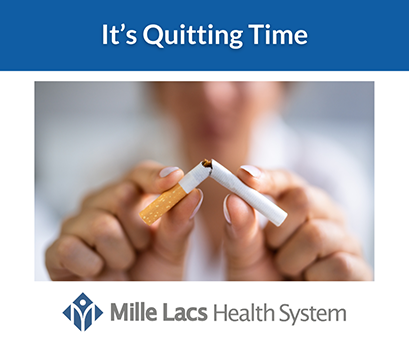It's Quitting Time
November 7, 2025
November marks Lung Cancer Awareness Month and the Great American Smokeout - an initiative of the American Cancer Society dedicated to helping people quit smoking and highlighting the importance of lung health.
Over the past 20 years, cigarette smoking in the U.S. has been cut in half. According to the Centers for Disease Control and Prevention (CDC), about 21% of American adults smoked cigarettes in 2005 compared to just under 10% today.
That decline represents real progress, but unfortunately, it hasn’t meant the end of nicotine addiction. As cigarette use has dropped, vaping - or the use of electronic cigarettes - has become increasingly popular. The CDC reports that about 7% of adults currently use e-cigarettes, and among young adults aged 18 to 24, the rate jumps to around 15%. Many of those who vape also continue to smoke traditional cigarettes, meaning they are using both products instead of quitting completely.
E-cigarettes are often marketed as a safer way to quit smoking, but health experts caution otherwise. The American Lung Association and CDC warn that vaping exposes users to nicotine - a highly addictive chemical - as well as ultrafine particles, heavy metals like nickel and lead, and other substances that can harm lung tissue and cardiovascular health. Some research shows that dual use (vaping and smoking) may even increase health risks compared to smoking alone.
The American Cancer Society reports that cigarette smoking increases the risk of at least 12 different types of cancer, including cancers of the lung, mouth, bladder, and pancreas. The best way to lower those risks is to quit all forms of tobacco and nicotine entirely. Quit now, and you can begin turning things around almost immediately:
20 minutes after your last cigarette: Heart rate and blood pressure begin to drop.
2 weeks to 3 months: Circulation improves and lung function increases.
1 to 12 months: Coughing and shortness of breath decrease.
1 to 2 years: The risk of heart attack drops dramatically.
5 to 10 years: Risk of cancers of the mouth, throat, and larynx are cut in half. Risk of stroke decreases.
15 years later: The risk of coronary heart disease is nearly the same as someone who never smoked.
Evidence-based methods - like nicotine patches, gum, lozenges, and prescription medications - can double a person’s chances of quitting for good. Most health insurance plans, including Medicare and Minnesota Medicaid, cover these products at little or no cost when prescribed by a provider. Free support is also available through Minnesota Quit Partnerat 1-800-QUIT-NOW, which offers coaching, online resources, and nicotine-replacement products.
As we recognize the Great American Smokeout and Lung Cancer Awareness Month, it’s a good time to take the next step toward a healthier future. Whether it’s your first attempt or your fifth, quitting all forms of tobacco - including vaping - is a choice that helps you breathe easier and live a longer, healthier life.
